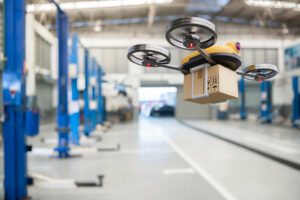Artificial intelligence (AI) is a highly topical subject. Indeed, hardly a week goes by without the press reporting a new feat by robots or algorithms that push the limits of machine capacity. Following in the footsteps of Amazon, Ali Baba and the many start-ups arriving on their markets, retailers have become aware of the importance of this technology, and their managers are well aware that AI represents a challenge for many of them in the decade to come.
The retail supply chain is no exception to the rule. It has long been strongly impacted by new technologies. We often consider 4 major technological bricks of AI (Dejoux, 2020):

- Language processing (identifying words, translating, formulating a response, etc.) found in voice picking (Amware, 2018).
- Computer vision (recognizing an image, following a trail...) which can be used to read a barcode or QR code, or to carry out an inventory.(Eyesee-L'Oreal, 2019)
- Robotics and automation (repeating a sequence of actions autonomously...) which has enabled the mechanization of warehouses or, more and more frequently with autonomous vehicles (AGVs) which combine automation and computer vision. (Amazon, 2021)
- Knowledge optimization (exploiting data to sort, find correlations or anomalies, forecast...), which is the basis of increasingly sophisticated algorithms for supply formulas, for example.
However, it is this last technological brick that is newer, and is arriving in all areas of the supply chain.
Why now?
The massive arrival of AI solutions in the supply chain is linked to the simultaneous maturity of several technologies.
- Algorithms to process massive amounts of data and develop ever-improving quality of results thanks to Deep-Learning.
- The development of processor speed, which enables these calculations to be processed within a suitable timeframe.
- Lower storage capacity costs (99.6% in 10 years), enabling us to store more data for less.
- Cloud computing, which harnesses the computing and storage power of remote servers.
- The Internet of Things (IoT), objects capable of capturing data (sensors, cameras, etc.) and sending them via the Internet to processing software without human intervention.
- 5G, the fifth generation of mobile networks, enables more objects to be connected on the same surface, with higher throughput, less latency (the gap between the transmission and reception of information) and lower energy consumption.
This combination of factors enables objects to send information in real time to servers, which process the data and immediately generate an appropriate response if necessary.
Five examples of applications immediately available in the supply chain
 Supply chain managers now have the technology to :
Supply chain managers now have the technology to :
- Forecasting business or sales. Using algorithms to retrieve, process and analyze data, AI offers datavisualization or data recommendation, enabling managers to determine the best approach.
- Testing and planning. Once the choice has been made, the AI is used in the form of a digital twin, a digital replica of the ecosystem. This enables the recommended solution to be put to the test and its relevance to be validated, or even multiple variants to be tested to determine the best one.
- Optimize warehousing and truck routes. AI's ability to take into account multiple data sources enables it to make more complex calculations than humans alone could. As a result, AI is able to define the best site to stock an item or the best location to store a pallet, particularly in an omnichannel context. With regard to transport, AI will help minimize the number of kilometers traveled or the time spent, while respecting delivery constraints and customer service quality.
- Tracking activity. Numerous solutions exist for tracking loads by means of beacons, so you know where your goods are. Similarly, the use of drone inventories enables regular checks to be made on the accuracy of stock levels. In other cases, AI is used to avoid errors by applying a confidence rate.
- Business management. By installing cameras on the ceiling of its warehouse and analyzing movements using AI, a logistician was able to identify weaknesses in its organization more easily.
For all these activities, the main challenges for operators will be to define their needs clearly, to be certain of the availability of data to run these algorithms, and to get the company moving on this new approach. Then, by making these new information processing and prescribing capabilities available to users, AI will make it possible to digitalize new tasks and processes that only humans were capable of carrying out.
In economic terms, Mc Kinsey estimates the annual added value of AI in distribution at over 12% of sales, including 2.5% in logistics . And this through inventory optimization, improved demand forecasting and warehouse optimization. (Mc Kinsey, n. d.)
By Philippe Merckling

